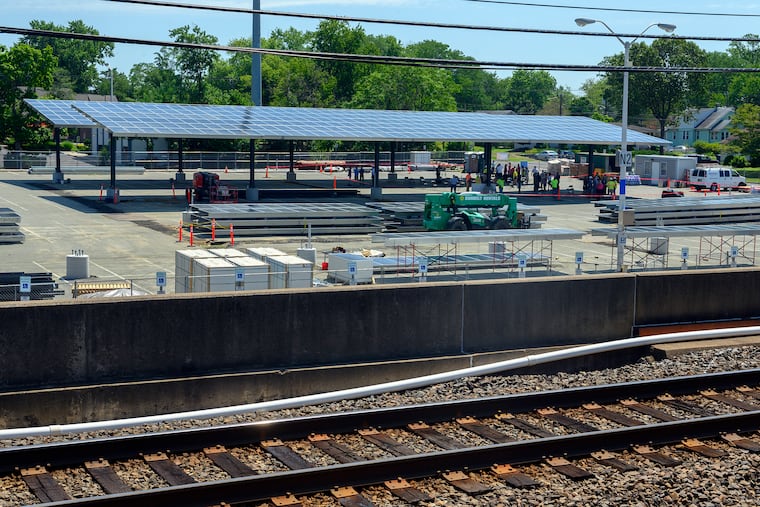DRPA breaks ground on solar project to power PATCO trains
The Delaware River Port Authority says a new 22 megawatt solar project will provide more than half the total electricity consumption for its PATCO operations through 50,000 solar panels on parking canopies at rail stations and installations on bridges.

By next year, PATCO riders could be shuttling over the Benjamin Franklin Bridge on trains powered at least in part by the sun.
The Delaware River Port Authority held a groundbreaking ceremony Wednesday for a 22-megawatt solar project. By 2021, solar panels will provide more than half the electricity consumed by PATCO rail operations, officials said.
Many of the 50,000 panels will be set on 133 parking canopies installed at four of PATCO’s nine New Jersey stations: Ashland, Lindenwold, Woodcrest, and Ferry Avenue. The agency’s four stations in Philadelphia are underground and without parking, so can’t be used for solar.
Panels will also be installed at the administration buildings and parking lots for the Commodore Barry and Betsy Ross Bridges, as well as DRPA headquarters in Camden.
Officials expect to save $12 million over 20 years through an agreement with SunPower Corp., a large solar company that has worked on commercial projects for Toyota, Johnson & Johnson, Walmart, and other corporations. It also specializes in government programs.
The DRPA announced the project in 2019. Construction began in winter at the Lindenwold station and is now underway at Ashland.
The installation will include a combination of flat roof mounts, ground mounted arrays, and solar canopies over parking, storage, and work areas.
John Hanson, CEO of the DRPA, said SunPower is assuming the up-front costs of construction as part of a solar power purchase agreement. SunPower will develop, own, operate, and maintain the system.
In return, Hanson said, the DRPA agreed to purchase the electricity generated by the system for 20 years. The arrangement will allow the agency to receive low-cost electricity while not having to put up the initial costs of building and maintaining the array.
The DRPA will pay $0.078 per kilowatt hour. The most current auction rate from Public Service Electric & Gas is $0.092 per kilowatt hour. SunPower can pursue tax credits and income generated from selling electricity back to PSE&G, the DRPA’s current provider.
“This monumental solar initiative demonstrates DRPA’s commitment to providing world-class transportation services that create significant savings, and added value for the public,” Hanson said.
Government and transportation agencies embracing utility-scale solar projects is a trend. Philadelphia has entered into a deal with the French company Engie to build a solar farm near Gettysburg that would produce 70 megawatts annually and supply city-owned buildings with 22% of their electricity. That project has not begun construction.
And SEPTA signed an agreement in April with the British firm Lightsource BP for a similar power agreement to finance and manage two large solar farms to produce 67 megawatt hours annually in Franklin County, Pa. — about 20% of the transportation agency’s annual electricity demand. That’s enough to power about 6,100 homes a year.
The DRPA said stations won’t be shut down for construction, which will occur in phases for each parking lot. Some of the parking lots will eventually be covered with a large number of canopies holding the solar panels. The statistics are:
Ferry Avenue: 20 canopies; 8,940 panels.
Woodcrest: 27 canopies; 12,280 panels.
Ashland: 20 canopies; 7,540 panels.
Lindenwold: 56 canopies; 18,040 panels.
“Clean energy and jobs, they go together,” New Jersey Senate President Stephen Sweeney said during Wednesday’s event. “Everyone is scared of this transformation, but it’s a good transformation.”